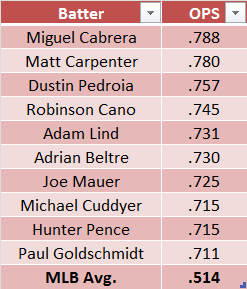Wacha's Right-on-Right Changeup Deadly
 David Golebiewski |
David Golebiewski |  Friday, October 25, 2013 at 10:36AM
Friday, October 25, 2013 at 10:36AM
Michael Wacha evened the World Series at one game apiece last night, limiting Boston's best-in-the-bigs offense to two runs over six innings while striking out six. Just a year removed from anchoring Texas A&M's rotation, Wacha became the first Cardinals starter to win a playoff game at Fenway Park since Bob Gibson took down the Sox in Game 7 of the 1967 Fall Classic. He also tied Gibson's franchise record for consecutive scoreless innings pitched in the postseason, tossing 19 clean frames between Pedro Alvarez's homer in Game 4 of the NLCS and David Ortiz's sixth-inning shot yesterday.
The key to Wacha's Game 2 win? His willingness to throw his changeup to same-handed hitters. Most right-handed starters shelve their changeups when facing righty batters, pulling the string just 7.2 percent of the time. Most pitchers don't have Wacha's changeup, though.
Wacha has thrown his plus-plus change to righties 17.1 percent of the time overall in 2013, and he used it 31.4 percent of the time versus Boston's righty hitters last night. Red Sox righties went a combined 0-for-6 with four strikeouts against Wacha's changeup. Xander Bogaerts went down swinging twice, while Shane Victorino came up empty once and Dustin Pedroia punched out on a foul tip. The whiffs are nothing new for Wacha, whose miss rate with his changeup against righties (47.4 percent) trails just Stephen Strasburg (51.8), Jarrod Parker (48.5), Homer Bailey (47.8) and Kris Medlen (47.7) among right-handed starting pitchers.
Command is big reason why Wacha's tumbling, mid-80s change is so effective. Check out his changeup location versus right-handed hitters this season:
Wacha's changeup location vs. righty batters in 2013
Wacha buries his changeup at righties' knees, throwing the pitch to the lower third of the strike zone 67.9 percent of the time. That's well above the 59.2 percent average for right-handed starters. He also rarely leaves a changeup belt high: Wacha tosses just 18.3 percent of his off-speed offerings to the middle of the plate against righties, way under the MLB average (26 percent) and lowest among right-handed starters save for Homer Bailey (16.3).
Why does that matter? Righty pitchers dominate when they throw their changeups low to same-handed batters (.248 opponent slugging percentage) and get eviscerated when they throw the pitch belt high (.541 slugging percentage). By locating his off-speed stuff low, Wacha has smothered righty hitters for a .125 opponent slugging percentage against the changeup (third-best in the majors, behind Strasburg and Bailey). No righty batter has taken Wacha deep on a changeup, and Willie Bloomquist is the only one to tally even an extra-base hit (a double during Wacha's second big league start back on June 4). Gibby must be proud of this 22-year-old prodigy.
 Cardinals,
Cardinals,  Red Sox,
Red Sox,  World Series,
World Series,  change-up | tagged
change-up | tagged  Boston Red Sox,
Boston Red Sox,  Changeup,
Changeup,  Michael Wacha,
Michael Wacha,  St. Louis Cardinals,
St. Louis Cardinals,  world series
world series

